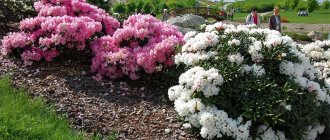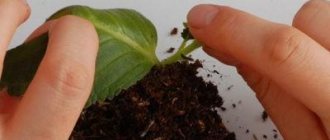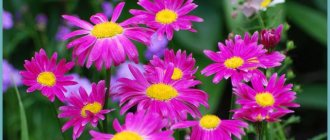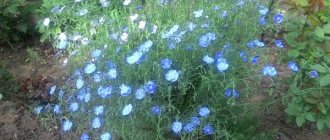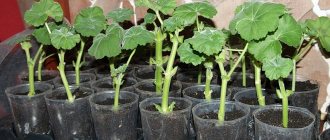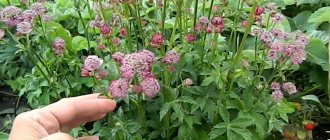Loading…
Loading…
If there is no rhododendron in the garden plot, then you will have to buy the first bush. But then you can propagate rhododendron in various ways and change with your neighbors, increasing your collection of flowering shrubs. Growing a new plant will not be quick, but you can save a lot on purchasing plants from a nursery.
Step-by-step instructions for propagation by cuttings
The easiest method of propagation is cuttings from an adult plant. It is distinguished by its speed; after just a couple of years, the young specimen begins to flower.
Note! It is recommended to carry out cuttings of rhododendrons in the summer. By mid-summer, young shoots become lignified by 50%.
Garden rhododendron
For harvesting, the best choice is a young top or part of a shoot that is half lignified. The suitable length of the shoot is 5-7 cm, it should have up to five leaves. Cuttings from the top of the shoot take root better.
How to take rhododendron cuttings:
- The cutting that is located under the bud is cut. The top and small leaves are removed, the rest are cut by one third. The bark on the bottom of the cutting is peeled until a white layer appears so that roots form faster.
- Next, the rhododendron goes through the stage of propagation by cuttings in water. The cut area is soaked for 12 hours in a growth stimulator solution. A solution of succinic acid with a concentration of 0.02% is suitable.
- The cuttings are planted in pots. The soil used is a 1:1 mixture of sand and peat, sprinkled with a layer of 8 cm. A layer of expanded clay drainage is lined at the bottom of the container. Sprinkle sand on top. The cuttings are planted at intervals of 5 cm.
- Water the cuttings generously and cover the pot. You need to hide it from the sun's rays, give the cuttings access to air twice a day and spray it with a spray bottle. The optimal temperature is 15-20°C.
- By September the cuttings will take root. You need to plant them in a box and move them to a cool, damp room (basement/cellar). Water twice a day.
- Rhododendron, propagated by cuttings, is planted in beds the following summer. The plant will bloom in 1-2 years.
Rhododendron cuttings
How to fertilize rhododendrons
pockets of infection , such as blackleg, or mold spots can occur I powder suspicious areas with Fundazol (it is convenient to use a soft brush for this) or spray it with a solution of the drug Maxim . I water the seedlings with a spray bottle as needed, trying not to dry out or over-moisten the substrate. After approximately 1.5-2 months, you can begin to accustom the seedlings to indoor conditions . Open crops have to be watered and sprayed more often, not forgetting to add water to the trays.
If rhododendrons were sown in peat tablets, then the seedlings do not need feeding for the first 2-3 months. If seedlings grow in a peat mixture, they need to be fed several times before planting outdoors. It is very convenient to use special liquid fertilizers for rhododendrons and azaleas , but you need to remember that for young plants in small containers you will need solutions 2-3 times less concentrated than the instructions advise. For example, the label recommends diluting one cap per 1 liter, but for watering seedlings one should dilute one cap per 2 liters. If there are no such ready-made fertilizers, you can make your own mixture: for 10 liters of water take 21.2 g of ammonium sulfate, 8.3 g of simple superphosphate and 6.3 g of potassium sulfate.
On clear sunny days, crops standing on the windowsill be shaded with a piece of lutrasil or tracing paper attached to the window frame, or, if possible, moved to a window facing east or north.
How to propagate rhododendron from leaf cuttings
How to propagate lavender from a bush using cuttings
A method similar to classic cuttings.
How to propagate rhododendron from leaf cuttings:
- In the second half of July, a large stem is selected and a leaf with an axillary bud is cut off with a knife.
- The cut is soaked in a growth stimulator. During planting, the petiole is buried a couple of centimeters.
- Further preparation is carried out in the same way as with conventional cuttings.
To root cuttings, you need to provide them with daily care. Planted cuttings should be in a shaded place. In warm weather, the film or glass frame is removed to allow any condensation to drain from the surface. After airing the cuttings, they are sprayed with 100 ml of water per 1 m².
On hot days, the film or glass cover can be completely removed. In the third week after moving to the greenhouse or planting in the ground, the cuttings will begin to take root.
Care when growing Rhododendrons
In the first years of their life, Rhododendrons grow very slowly. At the same time, they need quite labor-intensive, careful care, which consists of the following:
- watering;
- applying fertilizers;
- shelter for the winter;
- trimming bushes.
abundant watering during their flowering and during the period of intensive growth of the bushes, when next year's flower buds are being laid. For good growth and development, Rhododendrons constantly require increased atmospheric and soil moisture. Therefore, it is necessary to regularly moisten the soil and frequently spray the bushes, especially in dry and hot weather. To water them, use water that does not contain lime: rain, from a pond or river. Tap water needs to sit for some time.
to improve the soil around Rhododendrons every 3-4 years. To do this, a nutrient mixture is introduced into the tree trunks of plants: rotted cow manure and completely decomposed compost. 1-2 buckets per bush, and slightly buried to depth. In April-May, mineral fertilizers are added along with water - ammonium sulfate, superphosphate, potassium sulfate. Before the plants begin to grow, liquid mullein is added, and then during the summer, a solution of the composition is added twice: potassium nitrate - 1 part, superphosphate - 2 parts. It is not recommended to apply fertilizers to planted plants before they are completely rooted, or in late autumn, so as not to cause untimely plant growth and freezing in winter.
Shelter for the winter is necessary so that Rhododendrons can survive wintering well in cold areas and do not suffer from lack of moisture. Before the soil freezes, they are watered generously. Then stakes are driven in around the bushes, the height of which should be higher than the bushes, so that the branches and buds at their ends are not crushed when covering. A layer of fallen leaves of 15-20 cm is poured into the tree trunk circle to insulate the roots. Crossbars are placed on the stakes, to which protective materials are tied - Pine or Spruce branches, in a layer of 10-15 cm.
Such protection is quite sufficient until the onset of snow cover, which will then reliably protect the flower buds even during the onset of very severe frosts. The main thing is that all these protective shelters allow the air the plants need to pass through well.
In the second half of April, protective coverings are gradually removed, making sure that the bright spring sun does not burn the evergreen leaves. In areas with a mild climate, shelters for Rhododendrons for the winter serve to protect their evergreen leaves from burns by the winter and early spring sun.
Reproduction of rhododendrons by layering
How to propagate hydrangea by cuttings in spring
A simple method that takes little time. Suitable for those who need a small number of plants. It is most convenient to use for deciduous species.
Important! Rhododendrons obtained in this way live shorter than those grown from seeds.
Step-by-step instructions:
- Between the beginning of May and the beginning of June you need to get a shoot from the bottom of the bush. Using a bracket, it is pressed into a small hole (no more than 10 cm deep) and sprinkled with soil mixed with peat. The top is fixed on the support in a vertical position.
- Regular watering is required. Both the soil and the air around it should be moist.
- In winter, plants need to be covered.
- After a couple of years (in autumn or spring), the cuttings are cut off from the mother plant.
- In order for the cuttings to take root, it is necessary to plant it in a semi-shaded place without direct sunlight.
How to plant rhododendron cuttings
An alternative propagation option is air layering. The method is used mainly by foreign gardeners:
- It is necessary to select several branches from the mother plant. Make small cuts 1-2 cm long along the stem.
- Wrap the cut areas in fresh sphagnum moss and cling film, securing it at the top and bottom edges.
- After three weeks, roots will begin to form.
- In the fall, the cuttings are separated and planted in containers. They are placed in greenhouses to help the plants continue to grow.
Other ways to propagate these flowers
- Lateral layers. At the end of May, one of the bush shoots is pressed to the ground and sprinkled with peat. Allow such a “cutting” to take root for 1.5, or better yet, 2 years, and only after that cut off the mother branch and replant the resulting bush. By the way, it is believed that such propagation should not be used for all species, but it is suitable for deciduous azaleas.
- Air layering. The bark on one of the branches is carefully removed, and the wood is sprinkled with a root formation stimulator. This place is wrapped in damp sphagnum or peat and securely wrapped in foil. After the same 130 days, check your twig - if it has produced roots, you can cut it and transplant it into a box or a cozy place in the yard (be sure to cover such a bush with leaves for the winter).
- Dividing the bush. There are two methods available here: separation of the maternal offspring (difficult and responsible) or simple division (if the bush is old). All these manipulations are carried out when transplanting rhododendron.
- Graft. One of the most difficult methods. It is used by breeders when developing new varieties (scion and rootstock are taken from different species).
- Seeds. Another option for professionals. But avid flower lovers also use it. Seedlings must spend at least three years in the house. And such a plant will bloom even in its 9th year of life.
Propagation of rhododendrons by seeds
How to propagate clematis - propagation by cuttings in summer
Method for species plants. The first entries appear after 7-20 days. For the procedure, you will need a loose substrate into which water and air easily penetrate. A homemade mix of peat and river sand in a 1:1 ratio is suitable. When using a purchased mixture, soil for heather plants is suitable.
Important! It is recommended to steam the soil in the oven or microwave in advance.
A drainage layer is placed at the bottom of a pot or other container.
How to propagate rhododendron using seeds:
- It is necessary to stratify the seeds in advance in the refrigerator for 24 hours. Recommended temperature 3-5°C.
- Mix them with sand and spread them on top of the sterilized soil mixture. Seeds sown in a hole do not germinate.
- Spray the substrate and cover the box or container with film or glass.
- Required maintenance conditions: temperature 10-15°C, air humidity up to 40%, direct sunlight should not fall on the container.
- The soil is sprayed and aerated twice a day.
- The first shoots will appear in 2-3 weeks. Next, cotyledons are formed.
- Normally, by mid-September the seedling should have 5-10 leaves. It should be transplanted into a separate pot along with a lump of earth. A drainage layer 2-3 cm thick is made at the bottom.
- The seedlings are covered with glass or film, sprayed and ventilated twice a day.
- A year after the start of germination (the first half of spring), the length of the seedlings will be 5 cm. During this period, you need to transplant them into a container with a diameter of 5-7 cm. Suitable soil mixture: turf soil, sand, peat, coniferous litter in equal proportions.
- In the summer, pots should be placed in the garden in a place inaccessible to direct sunlight. From September, the seedlings are returned indoors for storage.
- In the third year, potted plants can be buried in the garden plot. Fertilize once a season; complex fertilizers for indoor flowers are suitable.
- In winter, the pots are moved indoors, and in the summer they are returned to the street.
Rhododendron seeds
By the fifth spring, plants can be planted in open ground. By this time, their height will be 40-70 cm. Pontian rhododendron specimens will grow to 80-120 cm.
Important! If the sprouts begin to rot due to the abundance of moisture, you need to sprinkle soot or crushed charcoal on the surface.
Planting young plants in a permanent place
To reliably root the plant, it is important to choose a suitable growing location. The culture develops well in areas with diffused lighting, protected from drafts and strong winds. Regarding soil quality, loose nutritious soils with a pH reaction of 4.5-5.0 are preferable. Plants are planted in a permanent place of growth in the spring. The layout of the holes is determined by the rhododendron variety. It will be comfortable for compact bushes to grow at a distance of 0.7-0.8 m from each other, and for spreading bushes a distance of at least 2 m is established.
It is important to check the position of the root collar relative to the soil surface. The best option is 2-3 cm above ground level.
Holes are formed around the plants. The planting procedure is completed with extensive watering and mulching of the soil. Peat and pine needles are used as mulch. A distinctive feature of rhododendrons is that the plants take a long time to develop with any method of propagation. It is possible that not all attempts to propagate the crop will be successful. But beautiful and lush rhododendron bushes are definitely worth the time and effort.
Dividing the bush
An effective but not common method used in the garden or country house. It guarantees the production of new plants, but the mother bush is severely damaged.
How street rhododendron reproduces using division:
- You will need an adult, large, healthy bush.
- In March, the mother plant is cut into several parts using a shovel. Each of them must have healthy roots and shoots.
- Small roots are removed with a knife.
- The separated bush is planted in acidic soil: small ones - in a container, large ones - in a greenhouse.
Follow-up care is the same as for a full-fledged young plant.
Important! In the first year, abundant watering and fertilizing are needed, and wintering in a greenhouse. The following summer, rhododendron is planted in open ground.
General recommendations for cuttings
Rhododendrons today grow almost all over the globe.
Most species of these plants are in Asia. An important condition for the growth and development of the crop is high humidity. Therefore, they can most often be found high in the mountains. Rhododendrons are evergreen and deciduous. The height of the bush is from several centimeters to several meters. Rhododendron does not like drafts, but responds positively to partial shade and slightly acidic soils. Depending on the variety, during flowering the plant is covered with beautiful inflorescences of different shades.
For cuttings of shrubs, flexible annual shoots are used: leafy, lignified and semi-lignified. The plant is also propagated by dividing an adult bush, grafting, suckers and seeds.
Attention! A common property of rhododendrons is long-term rooting. Deciduous varieties sprout roots within 1-1.5 months, evergreen varieties take about 4 months.
Grafting in greenhouse conditions
Using this method, a graft shoot and a 3-4 year old rootstock are connected. The grafting is done as close as possible to the roots of the rootstock. It is better to carry out the procedure in early autumn.
The rootstocks are dug up, planted in pots and moved to a greenhouse with a temperature of 5-10°C. After two weeks they take root. A few hours before grafting, the earthen ball of the plant is soaked.
Then, if desired, you can use one of the grafting methods:
- budding - placing a bud on a branch of the main plant;
- copulation - placing a stem into a cut of the main plant.
Thus, to propagate rhododendron, there are many ways. Which one to choose, each gardener decides for himself, based on his knowledge and available tools. It is better, of course, to stick to cuttings, since this option is much simpler and more productive.
Soil composition
It is believed that rhododendron prefers to grow in acidic and loose soil, so when planting seeds, it is necessary to create such conditions as much as possible so that no difficulties arise at this stage. There are several recipes that help create the best soil option.
- For an optimal substrate, it is necessary to combine one part of pine compost and two parts of peat and river sand. These are the proportions that will make an excellent mixture for rhododendrons.
- You can also avoid adding compost and use exclusively acidic peat, or as it is called high peat, as well as sand. In this combination, the amount of peat should be increased three times.
- The easiest way is to purchase a ready-made mixture for rhododendrons, or, as an option, a mixture for azaleas is suitable.
It doesn’t matter what mixture you choose, the main thing to remember is that it is recommended to pre-calcinate the sand, but steam peat and compost. If you strictly follow the recipe and adhere to the recommendations, then success is guaranteed.
Sources used:
- https://www.botanichka.ru/article/razmnozhenie-rododendronov/
- https://fermilon.ru/sad-i-ogorod/dekorativnye-kustarniki/razmnozhenie-rododendrona-cherenkovaniem-semenami.html
- https://glav-dacha.ru/razmnozhenie-rododendrona/
- https://fb.ru/article/324899/razmnojenie-rododendronov-cherenkami-otvodkami-i-semenami-rododendronyi-vyiraschivanie-i-uhod
- https://vsevogorod.ru/sad/cveti/rododendroni/podrobno_o_tom_kak_virastit_rododendroni_iz_semjan.html
- https://moyadacha.temaretik.com/1750667526673271574/vyraschivaem-rododendron-razmnozhenie-cherenkami-uhod-za-sazhentsami/
- https://vsaduidoma.com/2019/03/27/razmnozhenie-rododendronov-ot-a-do-yacherenkami-i-semenami/
- https://ogorodniki.com/article/vse-sekrety-vyrashchivanie-rododendrona-iz-semian
Answers from experts
Nina Panasyuk:
Azaleas are propagated by cuttings, or by layering. To do this, a small incision is made on the side shoot under the bud. There should be one pair of leaves above such a bud. After this, the cuttings are pinned to the ground with a wooden hook and sprinkled with soil.
They wait for the plant to take root, after which, carefully, so as not to damage the roots, they separate the cuttings from the mother plant and replant them in their own pot. If cuttings, then: for cuttings, take young shoots that are not yet completely woody; length of cuttings from 10 to 15 cm; the stalk is cut off with a sharp knife or blade under the bud; leaves from the bottom of the cutting are removed; the cutting is placed in a bowl with damp peat to a depth of approximately 5 cm; the ground around the cuttings is well crushed; the planted cuttings are covered with a jar, polyethylene or placed in a greenhouse; for rooting you need high air humidity and a temperature of about +25 degrees; cuttings need to be sprayed and ventilated regularly (up to 3 times a day) so that they do not rot
Cuttings take root in about six months. You can also see the material here: .floralworld/encyclopedia/plants/Rhododendron
Lyudmila Khlopnikova:
It's better not to try. A very demanding plant. It is difficult to care for, much less take cuttings. Buy better and take care.
✿ПеЛь ЛеТ@✿:
I tried, a branch of the azalea broke off, but nothing happened. But you can try. For cuttings, take semi-lignified shoots, cut them into cuttings 5-8 cm long, remove the lower leaves, and leave the top 2-3 leaves completely. Rhododendrons take root quite difficult, so it is better to keep the cuttings for 12-16 hours in a solution of growth stimulants: heteroauxin, indolylacetic (IAA), indolylbutyric (IBA) or succinic acids. Root in damp sand or vermiculite under a jar.
Valya:
Add more sphagnum and sand to acidic soil to create a very, very loose mixture. Stick the cutting into the greenhouse, spray it often, but do not water it. Woody, too hard shoots do not take root for a long time; soft green ones quickly wither and die. Cuttings with a semi-lignified base, 4-7 cm long, take root best. To avoid rotting, the lower leaves are removed. Fresh cuts of cuttings are treated with root formation stimulants, and their leaves are pollinated with growth substances and planted vertically to a depth of 1-2.5 cm. The same coniferous soil or sphagnum peat, in which adult azaleas feel best, are also recognized as the best substrate for rooting. The rooting period ranges from 3 to 5 weeks.
Lyudmila Gypsy:
that azalea is picky. You are right. I plant the cuttings immediately in the ground under the jar (Greenhouse effect) - survival rate is 5%. Good luck to you!
✿ПеЛь ЛеТ@✿:
Try it, but there is no guarantee that it will take root. For cuttings, take semi-lignified shoots, cut them into cuttings 5-8 cm long, remove the lower leaves, and leave the top 2-3 leaves completely. Rhododendrons take root quite difficult, so it is better to keep the cuttings for 12-16 hours in a solution of growth stimulants: heteroauxin or succinic acids, then plant them in sand under a jar. When the roots grow, transplant them into azalea soil.
Svetlana:
Azalea cuttings are very difficult to root; it can take about six months, but there is no guarantee of their survival. Plant directly into the ground, treating the cut with rootstock or heteroauxin. Cover with a jar on top to create a greenhouse effect. Ventilate the greenhouse daily, otherwise the cutting will rot. Keep the top layer of soil moist. You can sometimes shed it with a solution of root and heteroauxin. Periodically spray the cuttings with epin. And be patient, it will take a long time.
Annette:
I can say that my azaleas took a very long time to take root, a couple of months, that’s for sure. But I didn’t use any rooting agents, just light soil from under a pine tree and a little sand. If your climate is hot in summer, then it is very difficult to preserve cuttings, as light soil dries out very quickly. In my opinion, it is better to take summer cuttings rather than spring ones, although I could be wrong. I've been growing them for a long time. Our flower growers grew azaleas in greenhouses at one time. I heard from them that not all water is suitable for them / at the cellular level /. Plain water can simply destroy them. It's a matter of water hardness.
Elena Borgart:
Can you tell me the mixture of earth and sand?
Three options for vegetative propagation of azaleas
The first method is considered basic, the second is less common. As for deciduous propagation, it is suitable when the mother bush is very small.
It is best to take cuttings from varieties such as: Pointed, Ledebura, Daursky.
They take root poorly (but still, if you do everything correctly, you can root): Schlippenbach, Smirnov, Pontic, Kochi, Yellow rhododendron.
Cuttings: 1 way
The stalk is cut under a dormant bud.
To prevent the plant from wasting extra energy on photosynthesis and other processes occurring in the leaves, all lower leaves must be removed, as well as the middle ones (or cut to the middle).
Some gardeners advise cutting off a third of the top leaves.
On the lower part of the branch, the bark is removed so that the wood is exposed - this procedure improves future root formation.
- Dip the lower part of the cuttings in Kornevin or place in a solution of succinic acid (0.02%) for 16 hours.
- After this, the cuttings are planted in a mixture of peat and sand or simply wet sand. Moreover, there must be drainage at the bottom of the box (fill it at least 10 cm thick). The soil should be at least 8 cm thick. If you have a mixture with peat, you can form a two-centimeter sand layer on top.
- When planting, leave about 5 cm between cuttings.
- Immediately after placing them in the ground they need to be watered.
- Form a greenhouse (cover each cutting with a jar or cut plastic bottle, or even better, wrap the entire box with transparent film).
- Keep the cuttings in a shaded place at 16-20 degrees. Twice a day (morning and evening, when it is not yet/no longer hot) ventilate the box, and it is advisable to spray the planted branches and soil.
- The roots of cuttings appear in different ways. If you have a deciduous rhododendron, it will take root in 40-50 days. Evergreen - at 80-120. The rest will come a little later. It’s interesting that the branches take root very unitedly - just now they were all just sticking out of the ground, and suddenly - each one began to grow new leaves.
- From the end of September to the beginning of October, the “guys” can be dumped into separate containers. However, this could be another “brotherly” pot, only larger in size. Now between young azaleas you need to leave at least 8 cm of free space. The top of each plant must be pinched for better branching of the future bush.
Soil used for rooted branches: 2 parts leaf soil, 2 parts peat (acidic), 1 part each coniferous soil and sand.
Rooted cuttings must be kept cool (about 4-8 degrees - a basement or cellar is suitable for this purpose).
Cuttings: method 2
My friends call this method “for the lazy.”
- The cuttings are taken small (from 5 to 7 cm).
- They need to be planted in the same peat + sand, watered and wrapped in film. But after this, you should forget about planting for 75 days.
- During this time, the “baby” can take root. When the specified time has passed, the film is removed, the soil in the pot is loosened, and the cuttings are regularly watered.
Leaf propagation
This is done in July.
- The leaf is cut off along with the axillary bud. Along with it, also grab some bark (about 2.5 cm in length).
- Dip the bark into a growth stimulator (any kind, like Kornevin).
- Bury the bark and axillary bud 1.5 cm into sand + peat.
- The leaf needs to be kept in a greenhouse, with spraying and ventilation (everything is the same as with a regular cutting).
The rooting process will last quite a long time - from 130 to 160 days. True, the leaf may show the first signs of life 3 weeks later.
If such a mini-cutting tries to bloom in the spring, cut off the bud.
Preparation for cuttings
- When are cuttings of this flower prepared? After the bushes have flowered. True, these are different months for different species. Yes, deciduous rhododendrons take cuttings from approximately May 20 to June 10, and evergreen rhododendrons take cuttings from late June to early July.
- What should the ideal branch be like? You can use different shoots: lignified, annual semi-lignified, green top. Each one should have about 3 internodes and 5 leaves. Cut shoots 6-8 cm long. If you look at the variety of rhododendron, then in evergreen species, semi-lignified ones take root better, and in deciduous ones, apical cuttings that have just begun to become lignified take root better.
Seedling care
In the second year of life, cuttings growing in the basement may decide to bloom. Do not spare them: not only cut off all the buds, but also pinch the tops of the plant. Later it will only be more beautiful from this.
From the end of May to the beginning of June they can be moved to open ground, that is, to a flower bed. But for now this should be a “nursery”, that is, a non-permanent cozy place where the young plant will begin to get acquainted with the world around it.
Choose a semi-shaded area. It is desirable that the soil there be as described above (leaf, coniferous soil, acidic peat, sand). Don't forget to spray and water young bushes.
Since rhododendrons are still very tender, for the first winter, cover them with fallen leaves, spruce branches, sawdust or something like that.
When the bush has grown in the “nursery” for 2 or 3 years and is completely strong, it can be moved to a permanent place of residence. By the way, it can bloom as early as next spring after planting in open ground.
You will learn about caring for adult bushes from this video:
Rhododendron is a shrub of amazing beauty. It pleases not only with its lush flowering, but also impresses with the exquisite greenery of its leaves. But for many gardeners, rhododendron is a pipe dream. Some are afraid to settle the plant on the site, considering it capricious and demanding. Others cannot choose a variety that matches the climatic characteristics of the region. But, having settled it once, the summer resident cannot refuse to grow flowering shrubs. And then the question arises of how rhododendron reproduces, because getting another flowering specimen is the ultimate dream.

